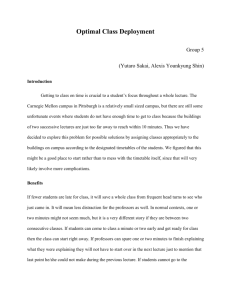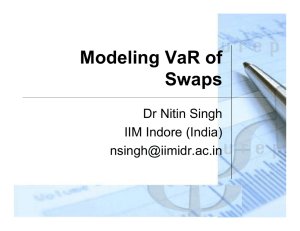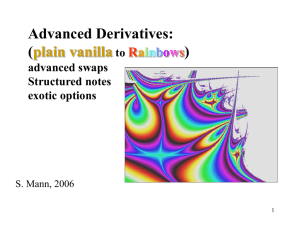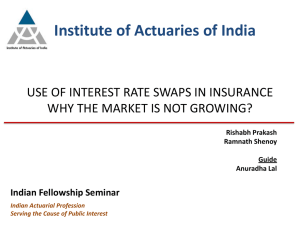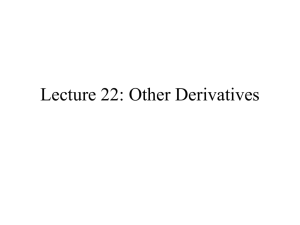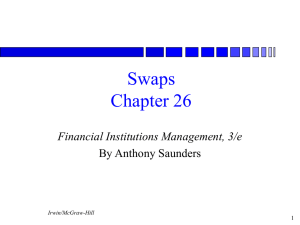Interest Rate Swaps Interest Rate Swaps: Overview FINC 456
advertisement
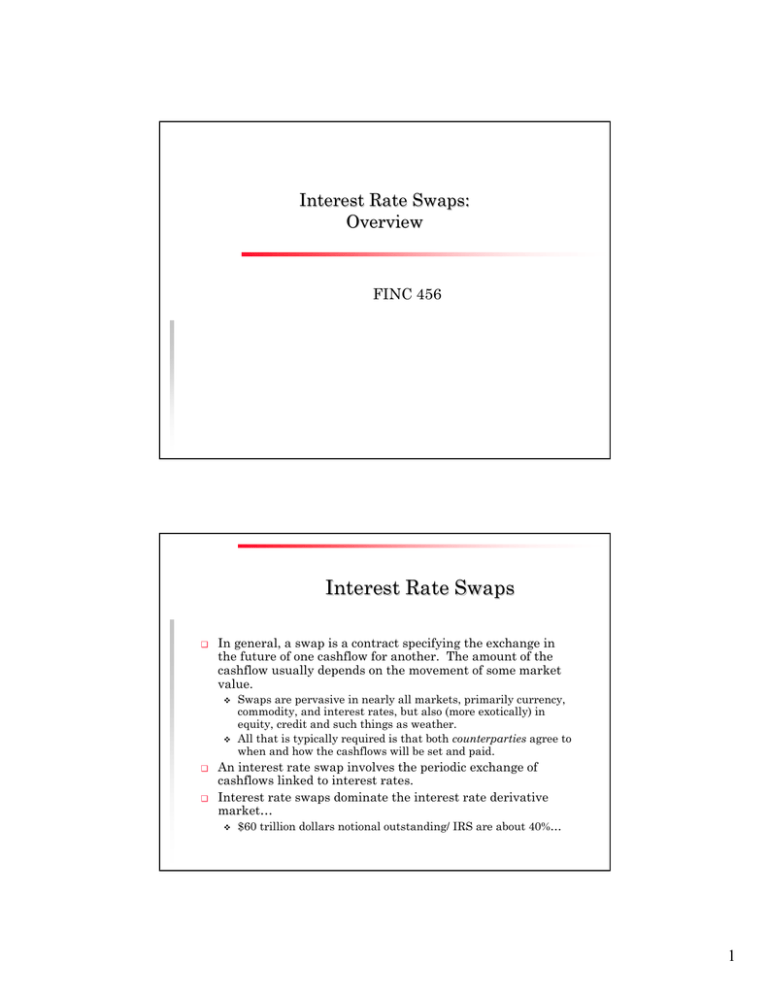
Interest Rate Swaps: Overview FINC 456 Interest Rate Swaps ❑ In general, a swap is a contract specifying the exchange in the future of one cashflow for another. The amount of the cashflow usually depends on the movement of some market value. ❑ ❑ Swaps are pervasive in nearly all markets, primarily currency, commodity, and interest rates, but also (more exotically) in equity, credit and such things as weather. All that is typically required is that both counterparties agree to when and how the cashflows will be set and paid. An interest rate swap involves the periodic exchange of cashflows linked to interest rates. Interest rate swaps dominate the interest rate derivative market… $60 trillion dollars notional outstanding/ IRS are about 40%… 1 Describing Interest Rate Swaps ❑ Interest rate swaps can be described by: ❑ Term sheets (contract specifications) Cashflows/Inflow-outflow diagrams “swap boxes” exposure diagrams Interest rate swaps most commonly involve one party paying a fixed interest rate and the other party paying a floating interest rate. For example 6M LIBOR vs. fixed (I.e. 6.25%) semiannually for 10 years. The cash amount of payments is calculated by applying the rates to some notional amount. Interest Rate Swaps: Mechanics ❑ For the standard (plain vanilla) interest rate swap, one party pays a fixed rate, and the other pays a floating rate, linked to some index (usually LIBOR) ❑ ❑ Each payment stream is called a leg of the swap… The payment on the fixed rate leg is easy to calculate, where the notional is Q, and the F is the fixed swap rate: fixed payment = Q × F × days basis The floating side, with R as the forward rate is: floating paymentt +1 = Q × Rt × days basis 2 Interest Rate Swap: Mechanics, con’t ❑ ❑ So at each payment date, the net cashflow is Cashflowt = Q × ( F − Rt −1 ) × days basis Question: from whose perspective is this cashflow? ❑ By convention, long swaps pay fixed and receive floating… So a short swap pays floating and receives fixed. Note that the index interest rate (think LIBOR here) is set at the beginning of the period, and the payment is realized at the end. This is exactly the way that floating rate bonds/loans work Interest Rate Swaps: Common uses ❑ Corporations employ interest rate swaps to dynamically change their financing structure from floating rate exposure to fixed, and vice versa. ❑ ❑ If interest rates are projected to rise, swaps provide a lowcost method to lock in current rates. If interest rates are projected to fall, swaps can allow corporations to take advantage of the lower financing costs. Swaps can also more precisely match financing risks with operational risks. Swaps can be used to lengthen or shorten the average maturity of a portfolio or liability structure. 3 Interest Rate Swaps: Term Sheet ❑ ❑ ❑ ❑ ❑ ❑ Receiving: 6M LIBOR Paying: 6.25% Notional: 100M Maturity: February 13, 2011 Periodicity: Semi-annual, normal reset Basis: Actual/360 Interest Rate Swap Cashflows ❑ For example, a 5 year, $100 MM notional swap, paying fixed and receiving floating could be depicted as: 15-Aug-01 15-Feb-02 15-Aug-02 15-Feb-03 15-Aug-03 15-Feb-04 15-Aug-04 15-Feb-05 15-Aug-05 15-Feb-06 Projected Floating Rates Fixed Rate 5.75% 6.01% 5.80% 6.01% 5.85% 6.01% 5.90% 6.01% 5.95% 6.01% 6.00% 6.01% 6.10% 6.01% 6.20% 6.01% 6.30% 6.01% 6.40% 6.01% PV $ $ $ $ $ $ $ $ $ $ (floating) 2,794,654 2,739,509 2,684,601 2,629,963 2,575,626 2,521,621 2,487,771 2,452,526 2,415,979 2,378,225 PV (fixed) Net Payment (125,208) $ 2,919,862 (98,063) $ 2,837,572 (72,331) $ 2,756,932 (47,970) $ 2,677,933 (24,941) $ 2,600,566 (3,201) $ 2,524,821 37,677 $ 2,450,094 76,101 $ 2,376,424 112,126 $ 2,303,853 145,809 $ 2,232,416 FV 1.0288 1.0586 1.0895 1.1217 1.1551 1.1897 1.2260 1.2640 1.3038 1.3455 PV 0.9721 0.9447 0.9178 0.8915 0.8658 0.8405 0.8157 0.7911 0.7670 0.7432 4 Interest Rate Swaps: “Swap Boxes” ❑ Swaps are often described by using boxes to represent counterparties and flows Note: this doesn’t give any information about the frequency of flows Fixed (Swap) Rate Corporation Swap Dealer LIBOR LIBOR+spread (200 bp) Bondholders Valuing Interest Rate Swaps ❑ ❑ The swap (fixed) rate is usually set so that the present value of both sides of the swap equal zero. A swap can be thought of as the interest payments due from borrowing at a floating rate and lending at a fixed rate (or vice versa). ❑ Another way of stating this: a swap is a portfolio of a coupon bond and a floating-rate note (FRN). The paying fixed side of a swap gains value if interest rates rise; it loses value when rates fall. 5 Interest Rate Swaps: A word about credit ❑ Swap “books” (that is, the total swap position of a bank) are often far in excess of the bank’s capital, on a notional basis. ❑ What are the credit risks associated with swaps? Are they similar to corresponding bond transactions? How might correlation factor into this? To mitigate concerns, banks often set up AAA subsidiaries to transact their swaps. Interest Rate Swaps: Generalizations ❑ Interest rate swaps are extremely customizable and have spawned a near infinite family of products. All types of indices…Treasury, LIBOR, Prime, CP, etc. Payments in different currencies Used to closely match operational exposures To take advantage of financing opportunities (recently, in Japan) Match financing with expenditures for multinationals Notional amounts that accrete/amortize, or are linked to other market quantities Frequently found in mortgage/financing related industries where pre-payments are possible 6
